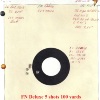There is an excellent article at the end of the Oct 2014 Shooting Sports USA on group size and accuracy:
http://www.nxtbook.com/nxtbooks/nra/ssusa_201410/ This foundational article was written by small bore prone competitors who wanted to shoot perfect scores. In small bore prone a Match is a 40 shot event of two twenty shot targets. The typical 1600 round Smallbore bore prone tournament is 160 rounds fired for record, divided up into four 40 round Matches. Therefore the referenced article assumes that a 40 round group is the baseline.
As anyone can see in table six, at least at 100 yards, a five shot group is 59% of the size of a 40 shot group, a 10 shot 74%, and a twenty shot 88%. A three shot group is below contempt, but three shot groups are the current standard for the shooting community because the leaders of the shooting community, that is in print Gunwriters, have convinced the shooting community that three shot groups are an exact measure of accuracy and consistency.
What we should recognize is that Gunwriters are shills for the industry. They really don't want to exhaustibly test the weapons they are given for several reasons. The first is time and materials. Gunwriters are given a flat fee for their articles, according to DPris $400, the less they shoot, the less they spend, the more money they get to keep. The less time and material they have to spend on the current article, the more time and less money they have to spend on the next. That is one reason, and another is because even though these guys get weapons that are "worked over", they are not interested in proving the inherent accuracy of the thing, because the inherent accuracy of the thing may not meet the communities' expectations.
Eley came to one of the Smallbore Prone National Matches to give a sales pitch for their in door range. Eley has a 50 meter range in the US and Lapua has a 100 yard range. I have been to the Lapua range for lot testing of ammunition in one Anschutz rifle. Both entities shoot 40 shot composite groups for the most promising ammunition. And yet, based on the lot tested case of Edge I purchased, once I got the round count up in matches, I am not impressed with the stuff. It basically takes a brick of 500 rounds before I really have confidence in the accuracy of my 22lr match ammunition. Forty rounds seems to be a lot of rounds, but even that is not definitive for consistency. It takes more shots.
Gunwriters are slowly moving the shooting community to 21 feet accuracy standards, one shot groups, and finally "virtual" groups where the gun writer imagines where the bullet goes. Because these guys are accepted as authorities, the shooting community will accept the new standards. Just as NASCAR fans are accepting computer simulation races as substitutes for a real car race.
@Hummer70 wrote an excellent article on service rifle accuracy:
Question on Neck Sizing .308 for M1A
http://thefiringline.com/forums/showthread.php?p=5424409
Note, when reading posts about Garand accuracy, how many shooters claim sub MOA or MOA rack grade Garands.
This is a three shot sub MOA group at 300 yards I made with a M70 Featherweight. I took this picture because it was so pretty. By the standards of the internet, irrefutable evidence that I have a half MOA rifle.

Not a half MOA group when made into a ten shot group, but I am going to state that a ten shot group slightly over 1 MOA is doing pretty good out of hunting rifle. It is the best one for that rifle at 300 yards. So, like everyone else, I am cherry picking my data.


At times I get lazy and try to sort out promising candidates with five shot groups and then later, come back and shoot ten shot groups to see if the trend is real.The five shot group was real promising.

the twenty shot, not nearly as stellar

The extreme spread at 300 yards was 7.6 inches, which is fine for a 1950's hunting rifle.

I really really, cut the load in my M70 with a new barrel. And I believe that the primary difference in group size between the FN Deluxe and my pre 64 M70, with its new barrel, is the barrel. The barrel on the FN is not as good as the barrel on my pre 64 M70. Can't wait to load more and take the thing to Talladega.

with 150's, this is exactly the velocity I want, and the accuracy is excellent. I have decided that velocities that approach 2800 fps, with a 150 grain bullet in my 270 Win, are over pressure.

I am going to bump this up and try for 2700 fps, currently this is an excellent group.

An over pressure load shot great at 300 yards, but was, overpressure



There are many half MOA groups inside these 270 round targets.





















